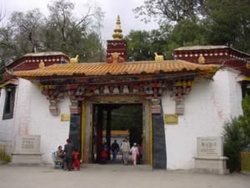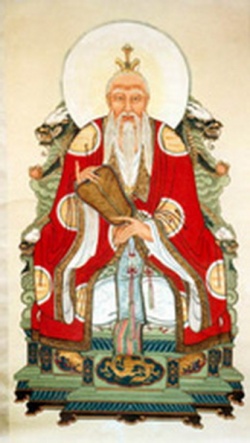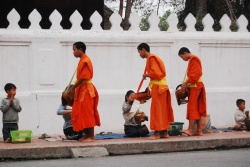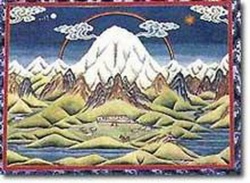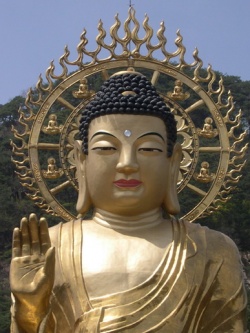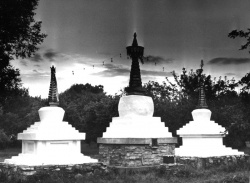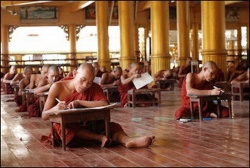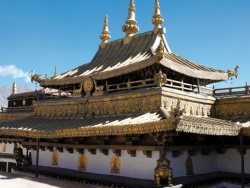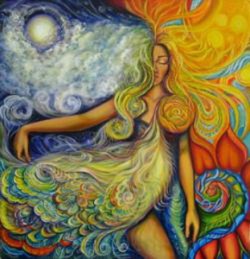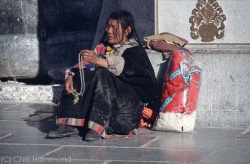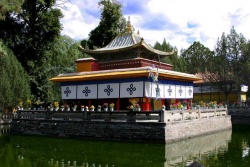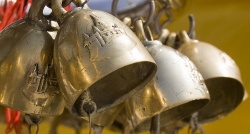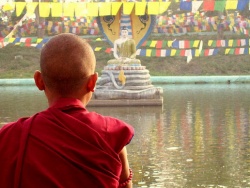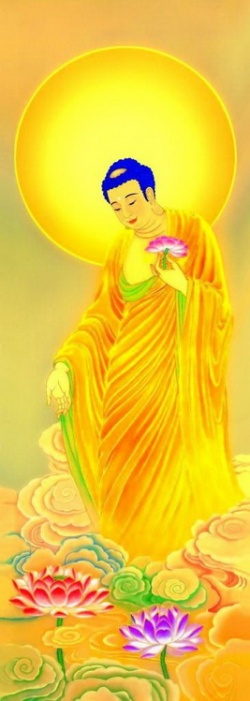Yogacara Theory - Part One: Background History
1. General Background
Yogacara is a special metaphysical teaching that gives us a unique view of the Mind and the Universe. The technical, scientific aspects of this view appear to have emerged around or a little after 200 AD, in the northwest corner of India. This represents a time when eastern Afghanistan and the regions that today form northern Pakistan, were very much a melting pot of several cultural, religious and philosophical trends. This region, which may broadly be referred to as Gandhava, was solidified into a political entity by Kanishka I, the great emperor of the Kushana dynasty (acc. 78 AD), about a century earlier.
Kanishka is one of the most celebrated monarchs of Asia. A significant cause of his historical fame was his close association with Buddhism, which he strongly promoted throughout his reign. Emperor Kanishka is credited with convening a great Buddhist Council and raising a huge Stupa near Peshawar, the remains of which may still be seen to this day. Nevertheless, Kanishka was very eclectic in his approach to religion.
Archeological study of the coins issued during Kanishka's reign, suggests that he respected and honored a variety of Indian, Greek and Iranian religious movements. It would seem that, apart from his personal faith in Buddhism, the Emperor promoted a liberal policy within his kingdom. The images on Kanishka's coins show regard for the pantheon of the Greeks, still worshipped in his time, as well as that of the Mazdean faith founded in Iran by the great prophet Zarathushtra. Some coins honor Siva, supreme deity of Hinduism. Other coins were printed with a standing image of the Sakya-Sage, accompanied by the Greek legend "Sakkamana Boddo' (i.e., Sakyamuni Buddha). In fact, it is probably that these representations of the historical Buddha are the earliest artistic renditions ever made, since previously the sage was only allowed to be represented symbolically by his empty seat, his bowl, his footstool, a wheel, the sacred Bodhi-tree, or a Stupa.
The epigraphs of Kanishka and his immediate successors mention different schools of Buddhism. In the Brahmi and Kharoshthi records of the time, there is mention of such Buddhist orders as the Mahasanghika and the Sarvastivada. The latter appears as the order most favoured by the Emperor, and one inscription records the coming of a dialectician from Nagara to Mathura for the purpose of counteracting the propagation of Mahasanghika doctrine. Historical evidence traces the spread of the Sarvastivada Order westward from Sindh and the Punjab into Afghanistan, undoubtedly as a result of imperial patronage, particularly during Kanishka's reign.
One significant Buddhist monarch ruling the northwest corner of the sub-continent in this early age, was the Indo-Greek king Menander (c. 150-135). It is known that he held the Swat Valley (Uddiyana) and the Hazara district, as well as the Punjab. His coins have been found as far north as Kabul, in Afghanistan, and to the south in Mathura. Contemporary kingdoms included the Shungas and Bactrians. The latter, Bactria (modern Balkh), was ruled by the line of Eucratides, who succeeded in pushing south and for a time annexing the kingdom of Taxila. One Shaka king who ruled this region, Gondophernes, has achieved historical fame due to his association with St. Thomas and the spread of early [[Wikipedia:Christianity|Christianity]].
Kushana governance gradually waned, diminished by the rising power of the Iranian Sassanids on their western flank, and nibbled away from the eastern side by smaller Indian factions. In 226 AD Ardashir overthrew the Parthians and his successor rapidly conquered Peshawar and Taxila.
The Northwest, therefore, was in constant fluctuation up until at least the third century AD, with Parthians, the Yueh-chih, the Shakas and finally the Sassanids, turn by turn, stirring a great maelstrom of different cultures and peoples together, in a manner ripe for the interchange of ideas and innovation.
2. Emergence of the Yogacara School
Unquestionably a product of the times, Yogacara stands on the innovative frontier as one product of the cultural interchange that blossomed in the first and second century Gandhava region. During its long and worthy history as a major school of Buddhist thought, two great masters of its doctrines especially stand forth, namely Vasubandhu (circa 290-370 AD)1 and Manjusrimitra (circa 700 AD), whose teachings we may discuss in brief.
Vasubandhu was trained in the orthodox Sarvastivada Order of Buddhism, which had its seat at Kausambhi (near modern Allahabad, in the centre of India) during the 2nd, 3rd and 4th centuries AD. He was introduced to an early version of Yogacara theory by his elder brother Asanga, who in turn had been the disciple of a sage named Maitreyanatha. Next to nothing about the latter is known, other than that legend reports he came from the "Kingdom of Shambhala' (approximately, modern Begram, otherwise known as the ancient kingdom of Kapisha, north of Kabul) located in the Afghanistan region, north-west of Peshawar.
The system which Asanga and particularly Vasubandhu formulated, and were to present in a number of pithy treatises that we still study today, not only presented the Buddha's original path of meditation in clear, scientific terms, but also delved into an analysis of the psychology of the mind, in ways not previously or so thoroughly revealed before. The new system that arose, thanks predominately to Vasubandhu's efforts, was a convergence of ancient Yoga and Buddhist streams of learning. Insofar as the intention of the Yogacara movement was not a philosophical speculation, but rather, intended as a return to a pure Buddhist mysticism, the new school was clearly founded on meditation. This practical contemplative movement, therefore, came to be known as the "school of Buddhist Yoga," or in other words the "Yoga-practice" school, hence the name yogacara. Beginning in the third century AD, this lineage has been passed down as an "Esoteric School" within the exoteric or outer branches of Buddhism.2
The name that Asanga and Vasubandhu gave to their school of mysticism has a special meaning. Yoga is spiritual science. It is neither a belief system nor a school of philosophical speculation. In the broadest possible sense, we may say that there are Buddhist yogins, Hindu yogins, Moslem yogins, Taoist yogins, Jewish yogins and Christian yogins. In other words, the term "Yoga" means mysticism (especially, if one thinks about it, in the sense of unio mystica, union with the Divine), and a Yogi or Yogini is essentially a mystic—the common factor being that in each and every spiritual tradition on earth, there are those who grasp Truth directly, not through intellectual speculation, thought or reasoning, nor argument and debate, but through immediate internal mystical or contemplative experience.
Yoga is centered on the practical application of the spiritual search for an experiential knowledge of Reality, regardless whether we name that reality Brahman, Allah, Ain-soph, God, the Absolute, Buddha, or simply Nirvana. We may see, from one cultural perspective to the next, ultimate Reality represented either in personal terms, or in an entirely impersonal way. Our intellectual grasp of what we mean by God, or Absolute, or whatever, may be very different, from person to person, according to the culture and outlook from whence such terms have arisen, but one significant point is fundamental, and that point is that the mystical experience—the common experience behind all these concepts, the direct experience acquired through meditation and Samadhi—is really one and the same.3
Practitioners of Yoga nourish themselves on their respective religious traditions, and may use speculative philosophy or science as a rational approach to augment their understanding, but they know that it is through direct mystical insight alone, the experience which comes from meditation, that one may acquire actual knowledge of the Truth. Cara means spiritual practice. Yogacara means the practice (cara) of "mystical Union" (yoga).
Asanga and Vasubandhu taught "Buddhist Mysticism", and this is the specific meaning of "Yogacara." It is the Yoga, or the practical mystical Way, as taught in the Buddhist tradition. To approach the gates of this Yoga-practice system, a certain view of the nature of mind is necessary. This view was expounded by the early Yogacara masters.
3. Historical Problems in Yogacara
Vasubandhu is treated as a single person in Tibetan history. This has raised some serious misunderstandings when it comes to the Tibetan study and presentation of Yogacara thought.
The Tibetan viewpoint presents Asanga and Vasubandhu as half brothers; they shared the same mother, but had different fathers. They both came from Peshawar, but while Asanga was ordained in the Mahisasaka Order, the younger brother Vasubandhu was ordained at Nalanda in central India and became a monk of the Sarvastavada Order. It was at Nalanda, so we are told, that he wrote a work on the "four oral traditions of Vinaya." He then transferred to Kashmir where, under Acarya Samghabhadra, he became a scholar of the Abhidharma, eventually composing an encyclopedic work known as the Abhidharmakosa. He then came into touch with some of his brother's works, which expounded a Mahayana doctrine said to have been promulgated in the Tusita Heaven by the future Buddha, Maitreya. At first Vasubandhu opposed his brother Asanga's position, even writing a number of anti-Mahayana texts, but later he changed sides and it was from then on that he composed the famous works that teach Yogacara under his name. Thus, after Asanga passed away, Vasubandhu assumed his brother's role as Abbot of Nalanda, where he taught his four leading students: Sthiramati, a leading teacher of Metaphysics (Abhidharma); Dignaga, the exponent of Logic-theory (Pramana); Gunaprabha, excellent in monastic Discipline (Vinaya); and Vimuktasena, a scholar of Transcendental Wisdom (Prajna-paramita). Vasubandhu, according to this account, was roughly a contemporary of the early Tibetan King Lha-tho Thori Nyentsen (circa mid-fifth century).
There are some serious problems with the above account. The Abhidharmakosa is very different in style and composition from the Yogacara works of Vasubandhu, let alone the Abhidharmakosabhasya, which is a refutation of the former. It becomes evident that Tibetan historians cobbled together a variety of fragments related to several different authors all having the name Vasubandhu. When the original fragments are sorted through, we find one Vasubandhu being the contemporary of one Indian king, and another being the contemporary of another king, centuries apart.
Two works on Abhidharma exist, both said to have been written by authors called Vasubandhu. One is the famous Abhidharmakosa, or "Treasury of Metaphysics", composed in Peshawar, the other, is the Abhidharmakosabhasya composed some centuries later in Ayodhya. The Vasubandhu who authored the latter (i.e., the Abhidharmakosabhasya) is known to us as having been the disciple of a renowned Abhidharma-master named Buddhamitra, and was appointed, according to Paramartha, by King Vikramaditya of Ayodhya to be tutor to the crown-prince Baladitya. Vikramaditya and Baladitya belong to the fifth century. The author of the Abhidharmakosa, on the other hand, resided in Peshawar, belonged to the Kashmiri Vaibhasika school of Sarvastivada metaphysics.
Vasumitra, a disciple of Gunamitra, who in turn was a disciple of Vasubandhu, the author of the Abhidharmakosa-bhasya, wrote a commentary in support of the latter work. This Vasumitra, we know, belonged to the Sautrantika school.
Vasubandhu the author of Yogacara works and brother of Asanga, on the other hand, resided at Kausambhi and was contemporary with King Chandragupta I, the father of Samudragupta, which places him in the fourth century.
Disregarding the author of works on monastic Discipline, at least three distinct men named Vasubandhu begin to emerge from the various historical fragments available to scholarly research. We can clearly distinguish the author of the Abhidharmakosa from that of the Abhidharmakosabhasya by the fact that they belong to two entirely different schools. The former is an exponent of the Vaibhasika (i.e., abhidharma) teachings of the Sarvastivada school, while the latter was an exponent of the Sautrantika.
To clarify, and for those who don't know what we are referring to here, Indian Buddhism in its long history gradually developed four distinct philosophical schools, each representing a way of interpreting the original teachings of the Buddha. These four philosophical schools, in historical order, were:
The Vaibhasika, or phenomenological school founded on the study of Abhidharma metaphysics, which in the north largely pertained to monks of the Sarvastivada Order, and in the south became a fundamental study of the Theravada Order.
The Sautrantika, which felt that the exponents of Abhidharma had deviated from the original teachings of the Buddha as expressed in the Sutras (hence their name, the "Sutra-school"). We can describe the Sautrantika as an anti-Abhidharma movement, based on a study of scripture.
The Madhyamaka school founded by Nagarjuna in the south of India in the first century AD.
And finally the Yogacara school, which arose in part as a reaction against the scholasticism that, after the time of Nagarjuna, tended to displace contemplative practice in the monasteries of India. This Yoga movement emerged, as we have said, in the third century AD.
Consequently when it is said that a certain person named Vasubandhu wrote a text supporting the philosophical outlook of one of these schools, while another wrote supporting the outlook of another school, it must be apparent that very different authors are involved, even though they carry the same name. The improbability of one Vasubandhu switching schools and composing a text in opposition to his earlier position is determined by the fact that the different authors in question were contemporary with or patronized by Indian Kings who lived in very different eras.
It therefore seems likely that at least three authors named Vasubandhu can be distinguished:
First: Vasubandhu, the author of the Abhidharmakosa. He was a monk of the Sarvastivada Order and lived in Peshawar. His leading disciple was Manoratha, and later another writer, Gunaprabha, author of the Vibhasha-sastra, was of the same line. Manoratha, as we know from his own works, was a confirmed follower of the author of the Abhidharmakosa. He apparently knew nothing of the counter Abhidharmakosahasya, which he certainly would have known had his teacher been the author of it.
Second: Vasubandhu, the brother of Asanga and the author of various works on Yogacara, who lived in Kausambhi (near modern Allahabad) circa 290-370 AD. He was a contemporary of King Chandragupta I and Samudragupta. His leading disciple was Sthiramati, and a later descendant of this lineage was Gunabhadra, who traveled to China in c. 430 AD. We know from the Chinese pilgrim Hiuen Tsang (see Beal, Buddhist Records of the Western World, Motilal Banarsidass 1981) that when he visited India in the seventh century, there could still be seen, in the Ghositarama of Kausambhi, the ruin of the old house where, in an upper chamber, Vasubandhu composed his famous Yogacara treatise, known as the "Thirty Verses on Perception" (Trimsika-vijnapti-karika). Hiuen Tsang also places Acarya Dharmapala, a later follower of Vasubandhu's lineage, in Kausambhi.
Third: Vasubandhu, the author of the Abhidharmakosa-bhasya, who lived in Ayodhya (= Saketa). He was a Sautrantika and contemporary of King Vikramaditya (455-467 AD). His disciples were Gunamati, Vasumitra and the renowned logician Dignaga. Gunamati taught a pupil called Sthiramati who was a contemporary of King Darasena I (c. 460 AD) of Valabhi, and thus not the same as the Yogacara author by the same name. Both Gunamati and Vasumati, from their writings, appear as staunch supporters of the Bhasya, as opposed to the Abhidharmakosa itself or, for that matter, the Yogacara position. Dignaga was the teacher of two very famous scholars, Dharmakirti and Dharmottara.
The Vasubandhu mystic who interests us, is of course the middle one in this historical time table. It was he who formulated Yogacara thought and wrote extensive commentaries on his brother Asanga's works.
We further find that the Yogacara outlook represented by this school later divided into two distinct systems, one which we might call the orthodox position and the other a popular offshoot. The orthodox position is that held by Vasubandhu's direct disciple Sthiramati, who advocated what is called nirakara-vijnana-vada (the doctrine of non-substantive consciousness) based on asserting the emptiness (sunyata) of both external objects and consciousness. This view was eventually transmitted by Paramartha (499-590 AD) to China, and is the same as that held by Tilopa, the founder of the Kagyu school of Tibet, as expressed in his song of Mahamudra called the Ganga-ma. It is also the viewpoint expounded by Acarya Manjusrimitra in the penultimate Yogacara treatise, the Bodhicittabhavana.
The popular or exoteric position, which appears to deviate from Vasubandhu's original exposition of Yogacara theory, is that of Acarya Dharmapala (see above). Dharmapala systematized a line of Yogacara thought known as sakara-vijnana-vada (the doctrine of substantive consciousness) that claims, although external objects do not independently exist, the mind itself (cittamatra) does exist as such. This view, which we know as Mind-only, presents Mind as ultimate reality. Dharmapala's line of thought was transmitted to China by Hiuen Tsang, the famous Chinese pilgrim mentioned above, in the seventh century and has since had a significant impact on the practice of Zen in Japan. Huge efforts on the part of generations of Tibetan scholars have been spent attempting to demonstrate in logical terms the impractical basis of this latter doctrine.
Regardless of scholastic efforts in whatever direction, it nevertheless appears that the original position held by the illuminated master Vasubandhu, is very much that of non-substantive consciousness, or in other words, the nirakara-vijnana view expressed by his direct disciple Sthiramati. This outlook asserts that observer and observed, or in other words, consciousness and external objects, are bound together in an indissoluble union impossible of splitting apart. Nevertheless, both lack credible claim to independent ontological existence. The term that describes this union is "simultaneous arising", which means that consciousness and its object arise, and can only arise, in immediate proximity. Or, in other words, one cannot come into being without the other. There are logical assumptions that follow from acknowledging this condition, that lead to what in modern terms would be called quantum theories of consciousness. Apparently practitioners of Yogacara grasped certain insights centuries ago, which only now are being realized by the most radical discoveries in new cosmological theory.
4. Source Texts for the Study of Yogacara
Vasubandhu is our leading author of the source texts of Yogacara theory and practice. Other major authors were his elder brother Asanga, and Asanga's teacher Maitreyanatha. Vasubandhu's chief disciple Sthiramati also wrote several texts in the form of commentaries on his master's works. These source texts are technical documents, and like any scientific manual, hard to understand. They need explication by a wise teacher. Difficult as the original source texts of this tradition are, for those wishing to know which are the authentic texts, here are the proper references.
According to Tibetan authorities, the works of Maitreyanatha are four:
Mahayanasutralamkara (Skt. text edited by S. Levi, Paris 1907),
Madhyantavibhanga (Skt. text edited by Yamaguchi, Nagoya 1934), and (3) Dharmadharmatavibhanga (Obermiller gives a summary analysis of this work in his translation of the Uttaratantra, 1931),
Uttaratantra (translated from the Tibetan into English by Obermiller, Acta Orientalia, Vol. IX, 1931). But it is doubtful that the Uttaratantra was written by the same hand as the other texts in this list, and may be pre-Maitreyanatha.
Abhisamayalamkara (Skt. edition by Stcherbatsky & Obermiller, BB XXII, Leningrad, Vol. I, 1929. Haribhadra's Aloka, a commentary on the Abhisamayalamkara, has been published by Wogihara, Tokya, 1932-5, and by Tucci, GOS, 62, Baroda 1932).
Asanga's most significant work is:
Yogacarabhumi-sastra, consisting of two texts, the Sravaka-bhumi and the Bodhisattva-bhumi. The Skt text, found in Tibet by Rahula Sankrityayana, has been edited by Bhattacharya.
Further works attributed to Asanga are:
Abhidharmasamuccaya (skt. text edited by Prahlad Pradhan, Visva Bharati Studies, 12, 1950),
Tattvaviniscaya (a commentary on the Uttaratantra, and
Madhyantavibhanga (attributed above to Maitreya).
The Tibetan historian Bu-sTon attributed eight treatises to Vasubandhu:
Vimsatika,
Trimsika,
Pancaskandha-prakarana,
Vyakhyayukti,
Karmasiddhi-prakarana
Commentaries on the Mahayanasutra-lamkara
Commentaries on the Madhyantavibhanga
Commentaries on the Pratityasamutpada-sutra.
For the Pancaskandha-prakarana see The Pancaskandha by Vasubandhu and its Commentary by Sthiramati, Annals of Bhandarkar Oriental Research Institute, XVIII, 1936-7, pp. 276-286, and Stefan Anacker, Seven Works of Vasubandhu, Ch. IV, M.B., Delhi 1984.
The Sanskrit texts of the Vimsatika and the Trimsika (with Sthiramati's commentary) were discovered by S. Levi and edited in Paris, 1925. These works, of course, have always existed in Tibet. The Vimsatika, along with the author's commentary, has been translated into French from the Tibetan by Poussin, Le Museon, 1921. English translations may be found in Stefan Anacker, Seven Works of Vasubandhu, M.B., Delhi 1984, and Thomas Wood, Mind Only, A Philosophical and Doctrinal Analysis of the Vijnanavada, Univ. of Hawaii 1991. Stefan Anacker attributes seven works to Vasubandhu: Vadavidhi, Pancaskandha-prakarana, Karmasiddhi-prakarana, Vimsatika-karika, Trimsika-karika, Madhyantavibhanga-bhasya, Tri-svabhava-nirdesa. However the Karmasiddhiprakarana listed here and also by Bu-sTon is a Sautantrika treatise, and not composed by "our" Vasubandhu. The Trisvabhava-nirdesa is not mentioned by Bu-sTon, but is nevertheless in close harmony with the thought and style of the Yogacara master Vasubandhu. Note that Dignaga criticizes the Vadavidhi as a treatise NOT composed by his teacher, i.e., the Sautrantrika Vasubandhu, but accepts the Vadavidhanya. The Vadavidhi therefore may be accepted as a treatise composed by our Vasubandhu, i.e., the Yogacara master.
We disagree with Bu-ston, and do not attribute the Karmasiddhi-prakarana to Vasubandhu, based on internal evidence. According to us, the correct works that may be attributed to the Yogacara Vasubandhu are:
Vadavidhi,
Pancaskandha-prakarana,
Vimsatika-karika,
Trimsika-karika,
Madhyantavibhanga-bhasya,
Tri-svabhava-nirdesa,
Vyakhyayukti
Plus the three general commentaries mentioned by Bu-sTon.
Yogacara Theory - Part Two: Evolving Intelligence >
Footnotes
1 The problem of the date of Vasubandhu has been discussed by S.R. Goyal, A History of Indian Buddhism, Meerut 1987, under the heading of "The Two Vasubandhus and the Guptas." Taking his lead from Frauwallner (On the Date of the Buddhist Master of the Law Vasubandhu, Rome 1951), Goyal distinguishes between the author of the Abhidharmakosa (known to have been a disciple of Buddhamitra) who, as we know from Hiuen Tsang, lived in Peshawar (Gandhara), and the Sautantrika Vasubandhu, author of the Abhidharmakosa-bhasya (a systematic critique of the former) who lived in Ayodhya during the reign of King Vikramaditya (c. 455-467 AD). As to "our Vasubandhu," the teacher of Yogacara, it is known that he was a contemporary of Emperor Candragupta I. Ramashankae Tripathi, History of Ancient India (Delhi 1942), gives the dates 320 to circa 335 AD for the reign of Candragupta I, and c. 335-375 for that of his militant successor Samudragupta. This situates the life of our Vasubandhu between 290 and 370 AD. Wogihara incorrectly places him between 420-500 AD and H. Ui between 320 to 400 AD. J. Takausu is closer to the mark when suggesting that H. Ui's dates must be too early by at least a century. See T. Kimura, J. Takausu, and G. Ono in Lanman Studies, p. 79 ff., 93 f. We also know from Hiuen Tsang (see Beal, Buddhist Records of the Western World, M.B. 1981) that in the Ghositarama of Kausambhi there could be seen, in the seventh century, the ruins of the old house where, in an upper chamber, Vasubandhu composed his famous treatise, the Trimsika-vijñapti-karika. We feel that this should settle the issue.
2 The somewhat flamboyant and charismatic 19th century Russian woman mystic, Elena Petrovna Blavatskaya, better known in America as "Madame Blavatsky," refers to the Yogacara school as it existed in Nepal in her era, when in Isis Unveiled, page 264, she wrote: "The Svabhavikas, or philosophers of the oldest school of Buddhism [in Nepal], speculate but upon the active condition (parvritti) of Essence, which they call Svabhavat, and deem it foolish to theorize upon the abstract and unknowable principle in its passive condition (nirvritti). Hence they are called atheists by both Christian theologians and modern scientists; for neither of the two are able to understand the profound logic of their philosophy." She was to be criticized by scholars for this statement, who claimed that no such school was known to exist. The name, first applied by Brian Hodgson (who spent more than twenty years in the Kathmandu Valley between 1821 and 1843), may be considered a misnomer; the esoteric school, however is a reality, and persists to this day amongst the Newar community.
3 Mystic tradition is like an underground stream, portions of which, generation after generation, bubble to the surface in different parts of the world, giving birth to one or another esoteric school. This is true for the Bengali Sahajiyas, for the Ch'an and Taoist schools of China, the Zen of Japan, the Yogacaras and Tantrikas of Nepal, and the Saivite siddhas of Kashmir, the Naths of Bombay, the Naqsbandhi Sufis of [[Wikipedia:Central Asia|Central Asia]], or the hidden Nazari dervish Masters of northern Pakistan, the Hasids of eastern Europe or the Hesycasts of Mt. Athos, as it is for the "Oral Traditions" of Tibet. Those who have by means of this wisdom-stream attained to higher planes of consciousness, in turn have made it their duty to inspire and guide others. Thus the same universal "golden rosary" (suvarnamala) of mystics (i.e., yogis and yoginis), separated into diverse strands, has continuously spread forth. In past ages this golden chain inspired sources of mysticism the world over. It has equally inspired circles of true Christian mystics in Europe and secret groups of Kabalists in the Levant. It is the stream that for long ages watered the deserts of Egypt, disseminating knowledge amongst Ismaili sects and Moroccan Sufis. Nothing is hidden to the unobscured consciousness of the true Adept (siddha), and the sagely brethren of Egypt's fraternitatis lucis are as much spiritually "in touch' with their Hindu counterparts in India, or their Buddhist counterparts in Tibet or Ladakh, as neighbours are in a single village.The classical Raj Yoga of India, epitomized in the wonderful Yogasutras of Patanjali's, owes its ancient origins to this same stream! See, for further confirmation, H. Oldenberg, Die Lehre der Upanishaden und die Anfage des Buddhismus, Gottingen 1915.)
